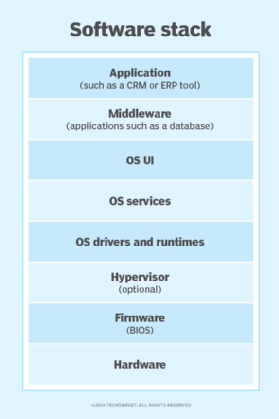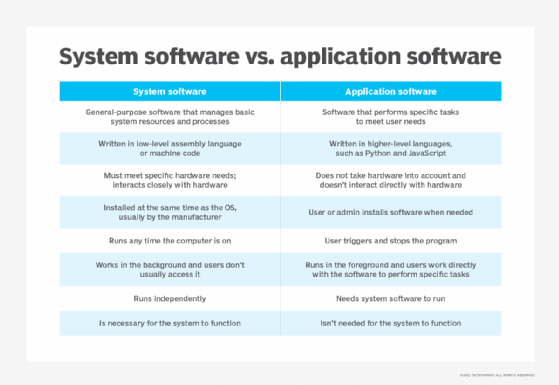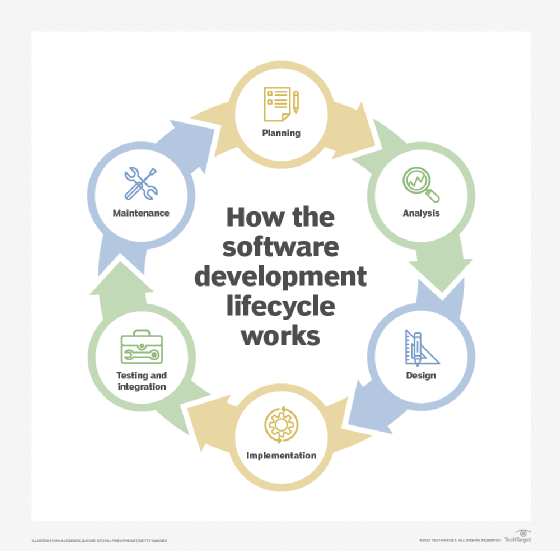System Software Can Be Described as End-user Software and Is Used to Accomplish a Variety of Tasks.
Software is a set of instructions, data or programs used to operate computers and execute specific tasks. It is the contrary of hardware, which describes the physical aspects of a computer. Software is a generic term used to refer to applications, scripts and programs that run on a device. It can exist thought of every bit the variable function of a computer, while hardware is the invariable part.
The ii main categories of software are application software and organisation software. An awarding is software that fulfills a specific need or performs tasks. System software is designed to run a computer's hardware and provides a platform for applications to run on peak of.
Other types of software include programming software, which provides the programming tools software developers need; middleware, which sits between system software and applications; and driver software, which operates computer devices and peripherals.
Early software was written for specific computers and sold with the hardware it ran on. In the 1980s, software began to exist sold on floppy disks, and later CDs and DVDs. Today, near software is purchased and directly downloaded over the cyberspace. Software can be found on vendor websites or application service provider websites.
Examples and types of software
Amid the various categories of software, the nigh common types include the following:
- Application software. The about mutual type of software, awarding software is a computer software package that performs a specific part for a user, or in some cases, for another awarding. An application can exist self-independent, or it can be a group of programs that run the awarding for the user. Examples of modern applications include office suites, graphics software, databases and database management programs, spider web browsers, give-and-take processors, software development tools, paradigm editors and advice platforms.
- Arrangement software. These software programs are designed to run a computer'due south application programs and hardware. Organization software coordinates the activities and functions of the hardware and software. In addition, it controls the operations of the figurer hardware and provides an surroundings or platform for all the other types of software to work in. The OS is the best example of organisation software; information technology manages all the other computer programs. Other examples of system software include the firmware, estimator language translators and system utilities.
- Driver software. Also known equally device drivers, this software is oft considered a type of arrangement software. Device drivers control the devices and peripherals connected to a computer, enabling them to perform their specific tasks. Every device that is connected to a computer needs at least one device driver to part. Examples include software that comes with any nonstandard hardware, including special game controllers, too as the software that enables standard hardware, such as USB storage devices, keyboards, headphones and printers.
- Middleware. The term middleware describes software that mediates between application and organisation software or between two different kinds of application software. For instance, middleware enables Microsoft Windows to talk to Excel and Word. It is also used to send a remote work request from an application in a computer that has one kind of Os, to an awarding in a computer with a different Os. Information technology too enables newer applications to work with legacy ones.
- Programming software. Computer programmers use programming software to write lawmaking. Programming software and programming tools enable developers to develop, write, examination and debug other software programs. Examples of programming software include assemblers, compilers, debuggers and interpreters.

How does software work?
All software provides the directions and data computers need to work and come across users' needs. Notwithstanding, the two different types -- application software and system software -- piece of work in distinctly different ways.
Awarding software
Application software consists of many programs that perform specific functions for finish users, such as writing reports and navigating websites. Applications can also perform tasks for other applications. Applications on a computer cannot run on their ain; they require a reckoner's OS, along with other supporting system software programs, to work.
These desktop applications are installed on a user's computer and utilize the computer memory to carry out tasks. They have upwards space on the computer's hard drive and do not need an internet connection to work. However, desktop applications must adhere to the requirements of the hardware devices they run on.
Web applications, on the other hand, but require internet access to work; they practise non rely on the hardware and system software to run. Consequently, users can launch web applications from devices that accept a web browser. Since the components responsible for the application functionality are on the server, users can launch the app from Windows, Mac, Linux or whatsoever other Os.
Organisation software
System software sits between the figurer hardware and the application software. Users do not interact directly with system software as it runs in the background, handling the basic functions of the computer. This software coordinates a system'due south hardware and software so users can run loftier-level application software to perform specific actions. System software executes when a reckoner arrangement boots up and continues running equally long as the organization is on.

Design and implementation
The software development lifecycle is a framework that project managers use to describe the stages and tasks associated with designing software. The first steps in the design lifecycle are planning the endeavor so analyzing the needs of the individuals who will employ the software and creating detailed requirements. After the initial requirements analysis, the pattern phase aims to specify how to fulfill those user requirements.
The next is step is implementation, where development piece of work is completed, so software testing happens. The maintenance stage involves whatever tasks required to keep the organization running.
The software blueprint includes a description of the structure of the software that will exist implemented, data models, interfaces between arrangement components and potentially the algorithms the software engineer will apply.
The software blueprint process transforms user requirements into a class that reckoner programmers can use to do the software coding and implementation. The software engineers develop the software design iteratively, adding particular and correcting the design equally they develop it.
The unlike types of software design include the following:
- Architectural design. This is the foundational design, which identifies the overall structure of the system, its main components and their relationships with one another using architectural design tools.
- High-level blueprint. This is the second layer of design that focuses on how the system, forth with all its components, tin exist implemented in forms of modules supported by a software stack. A loftier-level design describes the relationships between data flow and the diverse modules and functions of the system.
- Detailed pattern. This third layer of blueprint focuses on all the implementation details necessary for the specified compages.

How to maintain software quality
Software quality measures if the software meets both its functional and nonfunctional requirements.
Functional requirements place what the software should practice. They include technical details, information manipulation and processing, calculations or any other specific function that specifies what an application aims to accomplish.
Nonfunctional requirements -- also known equally quality attributes -- determine how the system should piece of work. Nonfunctional requirements include portability, disaster recovery, security, privacy and usability.
Software testing detects and solves technical issues in the software source code and assesses the overall usability, performance, security and compatibility of the production to ensure it meets its requirements.
The dimensions of software quality include the following characteristics:
- Accessibility. The caste to which a various group of people, including individuals who crave adaptive technologies such as voice recognition and screen magnifiers, can comfortably use the software.
- Compatibility . The suitability of the software for use in a variety of environments, such as with dissimilar OSes, devices and browsers.
- Efficiency. The power of the software to perform well without wasting energy, resources, effort, fourth dimension or money.
- Functionality. Software's ability to carry out its specified functions.
- Installability. The power of the software to exist installed in a specified environment.
- Localization. The various languages, time zones and other such features a software can office in.
- Maintainability. How hands the software can exist modified to add and improve features, fix bugs, etc.
- Performance. How fast the software performs under a specific load.
- Portability. The ability of the software to be easily transferred from one location to some other.
- Reliability. The software'south power to perform a required function under specific weather for a defined menses of time without whatsoever errors.
- Scalability . The measure out of the software's ability to increase or subtract performance in response to changes in its processing demands.
- Security. The software'southward ability to protect against unauthorized access, invasion of privacy, theft, data loss, malicious software, etc.
- Testability. How easy it is to exam the software.
- Usability. How easy it is to use the software.
To maintain software quality once information technology is deployed, developers must constantly adapt it to come across new customer requirements and handle issues customers identify. This includes improving functionality, fixing bugs and adjusting software code to prevent issues. How long a production lasts on the market depends on developers' ability to keep upwards with these maintenance requirements.
When it comes to performing maintenance, at that place are 4 types of changes developers tin make, including:
- Corrective. Users often identify and study bugs that developers must fix, including coding errors and other bug that go on the software from meeting its requirements.
- Adaptive. Developers must regularly make changes to their software to ensure it is compatible with changing hardware and software environments, such equally when a new version of the OS comes out.
- Perfective. These are changes that improve system functionality, such as improving the user interface or adjusting software code to raise performance.
- Preventive. These changes are done to keep software from failing and include tasks such equally restructuring and optimizing lawmaking.
Software licensing and patents
A software license is a legally binding document that restricts the use and distribution of software.
Typically, software licenses provide users with the right to 1 or more than copies of the software without violating copyright. The license outlines the responsibilities of the parties that enter into the understanding and may place restrictions on how the software can be used.
Software licensing terms and conditions generally include off-white use of the software, the limitations of liability, warranties, disclaimers and protections if the software or its use infringes on the intellectual property rights of others.
Licenses typically are for proprietary software, which remains the property of the organization, group or individual that created it; or for complimentary software, where users tin run, study, change and distribute the software. Open source is a blazon of software where the software is adult collaboratively, and the source code is freely available. With open up source software licenses, users can run, copy, share and change the software similar to free software.
Over the final two decades, software vendors have moved away from selling software licenses on a one-fourth dimension footing to a software-equally-a-service subscription model. Software vendors host the software in the cloud and brand it available to customers, who pay a subscription fee and access the software over the internet.
Although copyright can prevent others from copying a developer's lawmaking, a copyright cannot stop them from developing the same software independently without copying. A patent, on the other paw, enables a developer to prevent some other person from using the functional aspects of the software a developer claims in a patent, even if that other person developed the software independently.
In general, the more technical software is, the more likely information technology tin be patented. For example, a software product could exist granted a patent if information technology creates a new kind of database structure or enhances the overall performance and function of a computer.
History of software
The term software was non used until the tardily 1950s. During this time, although different types of programming software were being created, they were typically not commercially bachelor. Consequently, users -- more often than not scientists and large enterprises -- often had to write their own software.
The following is a cursory timeline of the history of software:
- June 21, 1948. Tom Kilburn, a figurer scientist, writes the earth's first piece of software for the Manchester Babe figurer at the University of Manchester in England.
- Early 1950s. General Motors creates the first OS, for the IBM 701 Electronic Data Processing Car. It is called General Motors Operating System, or GM Bone.
- 1958. Statistician John Tukey coins the word software in an commodity about reckoner programming.
- Late 1960s. Floppy disks are introduced and are used in the 1980s and 1990s to distribute software.
- November. three, 1971. AT&T releases the first edition of the Unix OS.
- 1977. Apple tree releases the Apple Two and consumer software takes off.
- 1979. VisiCorp releases VisiCalc for the Apple Ii, the first spreadsheet software for personal computers.
- 1981. Microsoft releases MS-DOS, the OS on which many of the early IBM computers ran. IBM begins selling software, and commercial software becomes bachelor to the average consumer.
- 1980s. Difficult drives go standard on PCs, and manufacturers start bundling software in computers.
- 1983. The free software movement is launched with Richard Stallman's GNU (GNU is not Unix) Linux project to create a Unix-like Bone with source lawmaking that tin be freely copied, modified and distributed.
- 1984. Mac OS is released to run Apple'southward Macintosh line.
- Mid-1980s. Primal software applications, including AutoDesk AutoCAD, Microsoft Discussion and Microsoft Excel, are released.
- 1985. Microsoft Windows 1.0 is released.
- 1989. CD-ROMs go standard and hold much more data than floppy disks. Large software programs can be distributed chop-chop, easily and relatively inexpensively.
- 1991. The Linux kernel, the basis for the open source Linux OS, is released.
- 1997. DVDs are introduced and able to agree more data than CDs, making it possible to put bundles of programs, such as the Microsoft Office Suite, onto i disk.
- 1999. Salesforce.com uses cloud computing to pioneer software delivery over the internet.
- 2000. The term software as a service (SaaS) comes into vogue.
- 2007. IPhone is launched and mobile applications brainstorm to have hold.
- 2010 to the present. DVDs are becoming obsolete as users buy and download software from the net and the cloud. Vendors move to subscription-based models and SaaS has get common.
This was last updated in March 2021
Continue Reading About software
- How to negotiate a practiced software subscription agreement
- 5 key software testability characteristics
- How practise software developers and architects piece of work together?
- Product vs. project mindset: Differences in software development
- What's the departure betwixt open source software and complimentary software?
Dig Deeper on Application direction tools and practices
-

embedded operating system
-

runtime
-

MS-DOS (Microsoft Disk Operating Arrangement)
-

platform
Source: https://www.techtarget.com/searchapparchitecture/definition/software



0 Response to "System Software Can Be Described as End-user Software and Is Used to Accomplish a Variety of Tasks."
Post a Comment